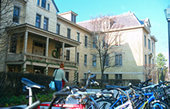
Year Built: original section, 1897; two wings added in 1917.
Named for: Father Stephen Badin, 1768-1853, first Catholic priest ordained in America (1793). In the early 1830s Badin purchased the land that would become Notre Dame from the government and early settlers. He planned to use it as a base for his missionary work in the Ohio and Mississippi river valleys. In 1835 he sold the land to the bishop of Vincennes, in southern Indiana, for a modest amount with the expressed hope that a school be established at the location. In 1842 the bishop’s successor deeded the land to Father Edward Sorin, CSC, who journeyed north with a band of religious brothers and founded Notre Dame. Badin’s remains lie beneath the floor of the Log Chapel, which is a replica of one he built at the site.
Capacity: 129 (second-smallest)
Female or male: 1918-1972, men; 1972 to present, women.
They Call Themselves: Bullfrogs since 1998. Before that, Attitude, as in bad.
Distinguishing features: a second-floor balcony with porch swing; single rooms for more than half of residents; wood-paneled hallways; dormers on the fourth floor that are a favorite haunt of bats. The first floor, now entirely given over to social space, has at one time or another housed a dining hall, the University’s first bookstore, a barbershop, a coffeehouse, a shoemaker and a travel bureau. The resident assistant on duty each night stations herself not in her own dorm room, as is the case in every other hall, but in a special second-floor room outfitted with cable TV and board games.
History made there: The building started out as the University’s Manual Labor School, where impoverished boys received training in blacksmithing, tailoring and other trades. The land east of Badin, now occupied by the Coleman-Morse building, provided a recreation area for the young apprentices, who dubbed it the Badin Bog for its poor drainage. In 1917, with the training school going broke, the wings were added and the building took on its present name and function. The men of Badin were displaced by Navy officers in training during World War II. Y chromosomes vacated for good with the advent of coeducation in 1972. Badin and Walsh Hall were the first dorms to switch gender.
They lived there as students: University President Edward “Monk” Malloy, CSC; distinguished early faculty members including three CSCs: John Zahm (of Zahm Hall fame, science professor and Catholic intellectual who examined the compatibility of the theory of evolution with Christianity), Joseph Lyons (Lyons Hall, English professor, university historian), and James Burns, president from 1919-1922; Heisman Trophy winner Angelo Bertelli; football great and current Minnesota Supreme Court Justice Alan Page.
He lived there as a non-student: Father Theodore Hesburgh, CSC, Notre Dame’s president emeritus. He was prefect of the third floor and chaplain to World War II veterans in the late 1940s. “They were the happiest years of my life.”
Lore: Harry Hunter, the “ghost of room 109,” was a fictitious resident during the 1960s (remember, there are no rooms on the first floor) who wrote bulletin board letters filled with scathing opinions of Badin and Notre Dame life. After World War II, returning GIs converted the second-floor shower room into a post-curfew beer garden. During the 1960s, Badin’s roof became a sunbathing beach. Outraged by the loss of their hall to women, Badin men hung a wreath of mourning on the front door.
Traditions: Rector Nancy Cook’s Boston terrier, Gidget, solves Badinite dilemmas in a humorous weekly column in the hall newsletter. Hall council meetings are family events with themes such as Dolly Parton night. Every finals week Badin unites to cook and eat a full-course turkey dinner using approximately 60 pounds of turkey. The leftovers last for weeks.